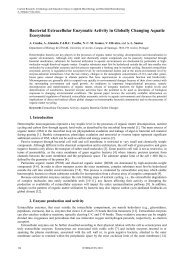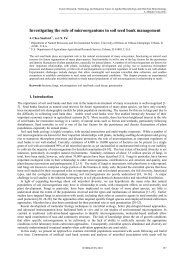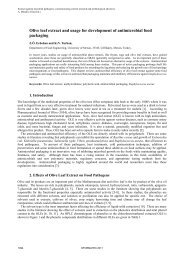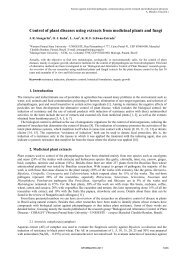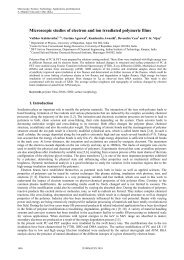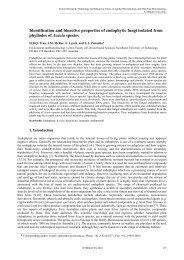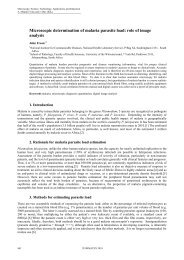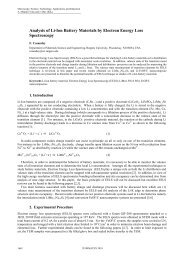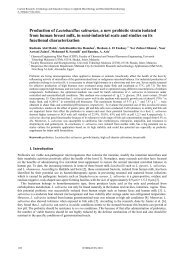Antimicrobial efficacy and systematic use of disinfectants - Formatex ...
Antimicrobial efficacy and systematic use of disinfectants - Formatex ...
Antimicrobial efficacy and systematic use of disinfectants - Formatex ...
Create successful ePaper yourself
Turn your PDF publications into a flip-book with our unique Google optimized e-Paper software.
<strong>Antimicrobial</strong> <strong>efficacy</strong> <strong>and</strong> <strong>systematic</strong> <strong>use</strong> <strong>of</strong> <strong>disinfectants</strong><br />
K. Steinhauer<br />
Schülke & Mayr GmbH, Research <strong>and</strong> Development, Robert-Koch-Str. 2, D-22840 Norderstedt, Germany<br />
Microbial contamination is <strong>of</strong> critical importance when it comes to production processes, especially in the pharmaceutical<br />
industry. Avoidance <strong>of</strong> microbial contamination throughout production processes is therefore crucial. However, what are<br />
the essentials <strong>of</strong> an effective hygiene regime? And what kind <strong>of</strong> hygiene measures are to be taken in order to be safe <strong>and</strong><br />
effective? This work demonstrates how a <strong>systematic</strong> review <strong>of</strong> monitoring data, sources <strong>of</strong> contamination, <strong>efficacy</strong> <strong>of</strong><br />
biocidal agents <strong>and</strong> <strong>efficacy</strong> testing <strong>of</strong> <strong>disinfectants</strong> according to European norms can help to set up a customised <strong>and</strong><br />
effective hygiene regime. <strong>Antimicrobial</strong> <strong>efficacy</strong> <strong>of</strong> biocidal actives will be looked at in more detail, as this provides the<br />
data for an appropriate choice <strong>of</strong> <strong>disinfectants</strong> in the first place. Furthermore, sources <strong>of</strong> microbial contamination will be<br />
presented in a <strong>systematic</strong> way <strong>and</strong> it is demonstrated how these data may be <strong>use</strong>d for a <strong>systematic</strong> risk assessment <strong>of</strong> any<br />
production site. A <strong>systematic</strong> review <strong>of</strong> microbial contamination derived from the monitoring data is provided <strong>and</strong> it will<br />
be demonstrated how monitoring data can be easily <strong>use</strong>d to set up effective hygiene measures. Last but not least, European<br />
norms (EN) <strong>use</strong>d for the overall evaluation <strong>of</strong> antimicrobial <strong>efficacy</strong> <strong>of</strong> <strong>disinfectants</strong> will be discussed.<br />
Keywords microbial contamination; cleanroom; hygiene measures; European norm; <strong>efficacy</strong> testing; <strong>disinfectants</strong>; EU<br />
GMP guideline<br />
1. <strong>Antimicrobial</strong> <strong>efficacy</strong> <strong>of</strong> various disinfectant actives<br />
Choosing an effective disinfectant regime that is appropriate to the hygiene requirements in a production plant poses a<br />
complex question. In this context, consideration <strong>of</strong> the antimicrobial <strong>efficacy</strong> <strong>of</strong> different biocides is an important<br />
decision-making basis. Not all disinfectant actives have the same spectrum <strong>of</strong> effect. When <strong>systematic</strong>ally using<br />
<strong>disinfectants</strong> it is therefore vital to cast a glance at the spectrum <strong>of</strong> effect <strong>of</strong> different <strong>disinfectants</strong>:<br />
Spectrum <strong>of</strong><br />
action<br />
Alcohols<br />
Quats<br />
Guanidines<br />
Aldehydes<br />
Active<br />
oxygen<br />
Peracetic<br />
acid<br />
Gram+<br />
bacteria<br />
+++<br />
+++<br />
+++<br />
+++<br />
+++<br />
+++<br />
_______________________________________________________________________________________<br />
Bactericidia Mycobac-<br />
tericidia<br />
Gram-<br />
bacteria<br />
+++<br />
++<br />
+++<br />
+++<br />
+++<br />
+++<br />
Mycobacteria<br />
+++<br />
-<br />
-<br />
+++<br />
+++<br />
+++<br />
Sporicidia Fungicidia Virucidia<br />
Bacterial<br />
spores<br />
Moulds<br />
Fig. 1: Illustrative presentation <strong>of</strong> the microbicidal <strong>efficacy</strong> <strong>of</strong> biocidal actives. The microbicidal <strong>efficacy</strong> <strong>of</strong> the selected biocides<br />
is subdivided into bactericidal, mycobactericidal, sporicidal, fungicidal <strong>and</strong> virucidal <strong>efficacy</strong>. +++: good <strong>efficacy</strong>; ++: moderate<br />
<strong>efficacy</strong>; - : inadequate <strong>efficacy</strong><br />
Fig. 1 gives for selected actives an overview <strong>of</strong> the spectrum <strong>of</strong> antimicrobial <strong>efficacy</strong> <strong>of</strong> different biocides, with a<br />
distinction being made between bactericidal, fungicidal, sporicidal, mycobactericidal <strong>and</strong> virucidal <strong>efficacy</strong>.<br />
The overview in Fig. 1 shows that alcohols, which act rapidly <strong>and</strong> effectively against bacteria, mycobacteria, fungi<br />
<strong>and</strong> vir<strong>use</strong>s, do not possess sporicidal <strong>efficacy</strong>. Quaternary ammonium compounds (quats) likewise have no effect<br />
-<br />
-<br />
-<br />
+++<br />
+++<br />
+++<br />
Yeasts<br />
++<br />
+++<br />
++<br />
++<br />
+++<br />
+++<br />
++<br />
+++<br />
++<br />
++<br />
+++<br />
+++<br />
Vir<strong>use</strong>s<br />
++<br />
++<br />
++<br />
++<br />
+++<br />
+++
_______________________________________________________________________________________<br />
against bacterial spores, nor are they effective against the mycobacteria that are <strong>of</strong> such significance as infection<br />
pathogens, especially in the medical area.<br />
This is also true <strong>of</strong> guanidines, which, compared with quaternary ammonium compounds, have rather better <strong>efficacy</strong><br />
against Gram-negative bacteria, but are rather poorer against yeasts <strong>and</strong> moulds.<br />
Aldehydes <strong>and</strong> active oxygen compounds (e.g. perform classic concentrate OXY) <strong>and</strong> peracetic acid have a broad<br />
antimicrobial spectrum <strong>of</strong> action. However, the fungicidal <strong>and</strong> virucidal <strong>efficacy</strong> <strong>of</strong> aldehydic compounds tends to be<br />
rather poorer compared with that <strong>of</strong> active oxygen compounds <strong>and</strong> peracetic acid, [1].<br />
2. Sources <strong>of</strong> contamination<br />
In addition to consideration <strong>of</strong> antimicrobial <strong>efficacy</strong>, consideration <strong>of</strong> microbial contamination plays a crucial role<br />
when choosing suitable <strong>and</strong> effective <strong>disinfectants</strong> in the production plant. Thus a critical look <strong>and</strong> identification <strong>of</strong><br />
actual or potential sources <strong>of</strong> contamination can provide a first indication <strong>of</strong> necessary disinfection measures:<br />
Fig. 2A shows an example <strong>of</strong> the microbial contamination <strong>of</strong> packaging material, which is a typical source <strong>of</strong> entry<br />
for contamination with spore-forming bacteria, moulds <strong>and</strong> yeasts. In areas where cardboard materials are <strong>use</strong>d<br />
extensively, <strong>and</strong> entry <strong>of</strong> spore-forming bacteria, yeasts <strong>and</strong> moulds has been detected during monitoring, for successful<br />
hygiene management it is therefore sensible to ensure the <strong>use</strong> <strong>of</strong> <strong>disinfectants</strong> with bactericidal, fungicidal <strong>and</strong><br />
sporicidal <strong>efficacy</strong>.<br />
And in the production process the employees themselves are also classic sources <strong>of</strong> entry <strong>of</strong> microbial contamination,<br />
especially with Gram-positive bacteria such as staphylococci <strong>and</strong> micrococci, which belong to the resident <strong>and</strong> transient<br />
microbiological flora <strong>of</strong> humans <strong>and</strong> other mammals [2]. Fig. 2B shows an example <strong>of</strong> the colonisation <strong>of</strong> human hair<br />
with Staphylococcus spp.<br />
A B<br />
Fig. 2: Illustration <strong>of</strong> microbial contamination. A: Microbiological contamination <strong>of</strong> packaging material. Spore-forming<br />
bacteria <strong>and</strong> also yeasts <strong>and</strong> moulds are <strong>of</strong>ten carried into the production process by packaging material. Depicted is the microbial<br />
contamination <strong>of</strong> a carton. B: Human hair after incubation on blood agar. Human hairs are naturally colonised with<br />
microorganisms, <strong>and</strong> especially Staphylococcus spp. can be detected on human hairs.<br />
In Fig. 3 the result <strong>of</strong> a swab test on a ring are shown. Here, the inner side <strong>of</strong> the ring that comes into contact with the<br />
skin was swabbed with a sterile cotton wool swab. The swab was then streaked out onto a sterile nutrient medium <strong>and</strong><br />
incubated. The result shows in an impressive manner the extent to which a human being can function as a potential<br />
source <strong>of</strong> contamination. Here too, with Staphylococcus epidermidis, it is a species that belongs to the resident flora <strong>of</strong><br />
the human skin. The data also show that jewellery can play an essential role as a source <strong>of</strong> contamination. Employees<br />
who are involved in critical process steps should therefore be urged to remove jewellery in the interests <strong>of</strong> production<br />
hygiene.<br />
As shown in Fig. 3, Staphylococcus epidermidis is a Gram-positive bacterium that is killed by <strong>disinfectants</strong> with<br />
proven bactericidal <strong>efficacy</strong>.
Staphylococcus epidermidis<br />
Staphylococcaceae (formerly<br />
Micrococcaceae)<br />
Gram + -bacteria<br />
Bactericidia<br />
Fig. 3: Detection <strong>of</strong> Staphylococcus epidermidis on the inner side <strong>of</strong> a ring that comes into contact with the skin. Shown is the<br />
microbiological contamination <strong>of</strong> a ring as a result <strong>of</strong> the intensive skin contact, constituting a potential contamination danger in the<br />
production process. Staphylococcus epidermidis is a Gram-positive bacterium, <strong>and</strong> can be effectively combated by the <strong>use</strong> <strong>of</strong><br />
bactericidal <strong>disinfectants</strong>.<br />
A further typical source <strong>of</strong> contamination is raw materials. For example, when raw materials <strong>of</strong> plant origin are <strong>use</strong>d,<br />
entry <strong>of</strong> Gram-negative bacteria such as Enterobacteriaceae or spore-forming Clostridium spp. can occur. If a risk <strong>of</strong><br />
entry <strong>of</strong> spore-forming Clostridium spp. or the likewise spore-forming Bacillus spp. is identified, appropriate sporicidal<br />
disinfection measures are necessary. However, if the risk can be excluded, <strong>use</strong> <strong>of</strong> sporicidally effective <strong>disinfectants</strong> is<br />
not necessary.<br />
3. Microbiological monitoring<br />
_______________________________________________________________________________________<br />
Analysis <strong>of</strong> the data obtained during regular microbiological monitoring is a further essential cornerstone for<br />
establishing a <strong>systematic</strong> disinfection regime.<br />
In Fig. 4 the different cleanroom areas (A-D) are depicted schematically. The permissible microbiological burden<br />
increases from cleanroom class A to D. Cleanroom class D can therefore be considered to be the area in which in a<br />
correctly run operation the greatest microbiological burden is to be expected, <strong>and</strong> as an example is to be considered<br />
more closely.
_______________________________________________________________________________________<br />
Air lock C<br />
to B<br />
CR area B<br />
LF-unit<br />
Class A<br />
CR area C<br />
CR<br />
area D<br />
A Microbiological contamination increases<br />
D<br />
Fig. 4: Schematic representation <strong>of</strong> different cleanroom areas (A-D). The permissible microbiological contamination increases<br />
from A to D. Abbreviations: LF – Laminar-Flow; CR – cleanroom.<br />
In Table 1 the microbiological findings obtained from various sampling sites in a class D cleanroom over a period <strong>of</strong><br />
several years are given as examples. The findings <strong>of</strong> the microbiological monitoring in Table 1 show that the detected<br />
microbial contamination is due essentially to the following microorganisms:<br />
- micrococci<br />
- spore-formers<br />
- moulds<br />
In the following, as a basis for the choice <strong>of</strong> a suitable disinfection regime, the microorganisms detected in the<br />
microbiological monitoring are to be considered more closely <strong>and</strong> classified according to their taxonomic group:<br />
Viewed taxonomically, micrococci belong to the Micrococcaceae. The “coccus” part <strong>of</strong> the name indicates the<br />
spherical shape <strong>of</strong> the bacterial cells. Micrococcaceae are Gram-positive bacteria, <strong>and</strong> occur widely in nature, including<br />
on the skin <strong>and</strong> mucous membranes <strong>of</strong> mammals. Representatives <strong>of</strong> the Micrococcaceae family are e.g. Kocuria<br />
rhizophila, or Micrococcus luteus [2]. The genus Staphylococcus was also classified as part <strong>of</strong> the Micrococcaceae<br />
family for a long time on account <strong>of</strong> its morphological characteristics [3]. However, according to more recent studies<br />
based on analyses <strong>of</strong> the DNA, the staphylococci have been classified as constituting their own family, the<br />
Staphylococcaceae [2]. Both Micrococcaceae <strong>and</strong> Staphylococcaceae belong to the large group <strong>of</strong> Gram-positive<br />
bacteria that is in contrast to the Gram-negative bacteria. Gram-positive bacteria <strong>and</strong> Gram-negative bacteria differ<br />
essentially in their cell wall structure. With regard to susceptibility to biocides, among themselves Gram-positive<br />
bacteria <strong>and</strong> Gram-negative bacteria consequently each behave similarly. However, when compared directly with each<br />
other, on account <strong>of</strong> their different cell wall structures Gram-positive bacteria <strong>and</strong> Gram-negative bacteria differ in their<br />
susceptibility to biocides. Therefore, in tests <strong>of</strong> <strong>disinfectants</strong> for their bactericidal <strong>efficacy</strong> according to European<br />
norms, both Gram-positive <strong>and</strong> Gram-negative bacteria are always <strong>use</strong>d in the testing.
Table 1: Example <strong>of</strong> microbial contamination detected in cleanroom class D during a regular microbiological monitoring inspection.<br />
*[4] Annex 1 EU GMP Guidelines (2008 rev.)<br />
Site Sample Limit value* 2005 2006 2007 2008 2009<br />
Cleanroom<br />
Cl. D<br />
Cleanroom<br />
Cl. D<br />
Cleanroom<br />
Cl. D<br />
A 500 cfu/m 3 138<br />
cfu/m 3<br />
(sporeformers)<br />
B 40 cfu/h 3<br />
cfu/h<br />
(micro-<br />
C<br />
_______________________________________________________________________________________<br />
cocci)<br />
300 cfu/75 cm 2 24<br />
cfu/<br />
75 cm 2<br />
(sporeformers,micrococci)<br />
40<br />
cfu/m 3<br />
(sporeformers,<br />
moulds))<br />
2<br />
cfu/h<br />
(spore-<br />
formers)<br />
8<br />
cfu/<br />
75 cm 2<br />
(sporeformers,micrococci)<br />
10<br />
cfu/m 3<br />
(micrococci)<br />
0<br />
cfu/h<br />
48<br />
cfu/<br />
75 cm 2<br />
(sporeformers,micrococci)<br />
0<br />
cfu/m 3<br />
0<br />
cfu/h<br />
9<br />
cfu/<br />
75 cm 2<br />
(sporeformers,micrococci)<br />
20<br />
cfu/m 3<br />
(micrococci,<br />
moulds)<br />
2<br />
cfu/h<br />
(moulds)<br />
4<br />
cfu/<br />
75 cm 2<br />
(sporeformers)<br />
Under hostile environmental conditions spore-forming bacteria are able to form endospores. Endospores are<br />
extremely resistant survival forms that are intrinsically inert in the face <strong>of</strong> many environmental influences, <strong>and</strong> can also<br />
survive temperatures > 100°C undamaged. The genus Bacillus with more than 100 species includes the best<br />
characterised representatives among the aerobic spore-forming bacteria. In addition to Bacillus subtilis, mention must<br />
be made in this connection <strong>of</strong> species such as e.g. B. megaterium, B. anthracis, B. cereus, B. licheniformis or<br />
B. thuringiensis, some <strong>of</strong> which have a considerable pathogenic potential [5].<br />
As saprophytes, aerobic spore-forming bacteria are ubiquitous in the environment, <strong>and</strong> are present both in the ground<br />
<strong>and</strong> in water.<br />
The ability to form endospores, which are resistant to drying out, also results in the extensive dissemination <strong>of</strong><br />
endospore-forming bacteria by the air [5]. Thus Rahman et al. (2006) in their examination <strong>of</strong> eye drops were able to<br />
detect Bacillus spp. among others as contaminants in the containers that were in <strong>use</strong> [6].<br />
A further important genus among the endospore-forming bacteria is the genus Clostridium, which combines<br />
aerotolerant <strong>and</strong> anaerobic spore-forming Gram-positive bacteria. Clostridia, which like Bacillus spp. are ubiquitous in<br />
the environment, are also to be found as a component <strong>of</strong> the intestinal flora, <strong>and</strong> as pathogenic bacteria are frequently<br />
associated with a number <strong>of</strong> serious infections [7]. Clostridium botulinum, as a result <strong>of</strong> its ability to produce highly<br />
potent neurotoxins, is the most important <strong>of</strong> these pathogens, being the most lethal [8]. With regard to food poisoning,<br />
Clostridium perfringens is one <strong>of</strong> the most significant pathogens: in an investigation <strong>of</strong> cases <strong>of</strong> food poisoning in<br />
Engl<strong>and</strong> <strong>and</strong> Wales between 1992 <strong>and</strong> 2000, Adak et al. (2002) identified C. perfringens as the second most lethal foodpoisoning<br />
pathogen after Salmonella [9].<br />
Clostridium sporogenes is closely related to the proteolytic strains <strong>of</strong> C. botulinum, although the endospores <strong>of</strong><br />
C. sporogenes are about 5 times more resistant [8].<br />
Viewed taxonomically, moulds belong to the fungi. At the same time, in the technical area a differentiation is<br />
frequently made between the filamentous fungi, to which mycelium-forming fungi belong, <strong>and</strong> the non-filamentous<br />
yeast fungi. This differentiation on the basis <strong>of</strong> morphological characteristics with regard to mycel formation is also<br />
reflected in the testing <strong>of</strong> <strong>efficacy</strong> <strong>of</strong> biocidal substances: thus a differentiation is made between levurocidal <strong>and</strong><br />
fungicidal <strong>efficacy</strong> <strong>of</strong> biocides, with levurocidia indicating <strong>efficacy</strong> against yeasts, <strong>and</strong> fungicidia <strong>efficacy</strong> against<br />
yeasts <strong>and</strong> filamentous fungi (therefore against moulds). In the case <strong>of</strong> testing for fungicidia, the conidiospores <strong>of</strong> the<br />
filamentous mould fungi as well as the vegetative cells <strong>of</strong> the yeast are <strong>use</strong>d in the test <strong>of</strong> <strong>efficacy</strong> [10].
_______________________________________________________________________________________<br />
Mould fungi are ubiquitous <strong>and</strong> are subject to mainly aerogenic dissemination throughout the world [11]; [12]. The<br />
spectrum <strong>of</strong> the different mould fungus species is subject to seasonal oscillations: in their study <strong>of</strong> the presence <strong>of</strong><br />
different fungal species in the air, increased numbers <strong>of</strong> Cladosporium spp. <strong>and</strong> Alternaria spp. were detected by<br />
Fröhlich-Nowisky et al. (2009) in summer <strong>and</strong> autumn, but in winter <strong>and</strong> spring they detected increased numbers <strong>of</strong><br />
Penicillium spp. <strong>and</strong> Blumeria graminis [13].<br />
4. Microbiological reports – benefits for estimation <strong>of</strong> the risk<br />
On the basis <strong>of</strong> taxonomic affiliation, conclusions can be reached that are helpful in the selection <strong>of</strong> suitable<br />
<strong>disinfectants</strong>. For this, individual reports <strong>of</strong> the <strong>efficacy</strong> (e.g. EN 1276, EN 1650, EN 13704, EN 13697) <strong>of</strong> the biocides<br />
under consideration serve as a basis for an evaluation.<br />
The <strong>efficacy</strong> tests according to EN are divided into different phases that depict the similarity <strong>of</strong> the tests to practical<br />
conditions. Phase 1 quantitative suspension tests form the basic test, <strong>and</strong> are carried out without organic loads (EN 1040<br />
(bactericidia) [14]; EN 1275 (fungicidia) [15]; EN 14347 (sporicidia) [16]). These tests are the furthest from <strong>use</strong> in<br />
practice. The tests in phase 2 simulate practical conditions more closely, <strong>and</strong> phase 2 consists <strong>of</strong> 2 stages: quantitative<br />
suspension tests, phase 2 / step 1, which are carried out in the presence <strong>of</strong> organic load (EN 1276 (bactericidia) [17], EN<br />
1650 (fungicidia) [10], EN 13704 (sporicidia) [18]) <strong>and</strong> quantitative microorganism carrier tests, phase 2 / step 2, in<br />
which in addition to the presence <strong>of</strong> organic load practical <strong>use</strong> on st<strong>and</strong>ardised surfaces is also simulated (EN 13697<br />
(bactericidia / fungicidia) [19]). EN 13697 can be modified by the <strong>use</strong> <strong>of</strong> bacterial endospores (e.g. Bacillus subtilis) so<br />
that testing for sporicidal <strong>efficacy</strong> is possible (EN 13697 mod.).<br />
In the case described (see Table 1) spore-forming bacteria, Micrococcaceae <strong>and</strong> moulds were detected. Thus, for<br />
effective hygiene management in this example <strong>disinfectants</strong> must be selected for which sporicidal, bactericidal <strong>and</strong><br />
fungicidal <strong>efficacy</strong> has been proven according to the appropriate EN tests.<br />
Using the example <strong>of</strong> <strong>efficacy</strong> against spore-forming bacteria, in the following it should be seen how the results from<br />
the monitoring, together with the specific tests <strong>of</strong> <strong>efficacy</strong> <strong>of</strong> a disinfectant in accordance with European norms (ENs)<br />
can be <strong>use</strong>d for a <strong>systematic</strong> analysis <strong>of</strong> the risks:<br />
As verification <strong>of</strong> the sporicidal <strong>efficacy</strong> <strong>of</strong> <strong>disinfectants</strong> tests according to EN 14347 (phase 1), EN 13704 (phase 2 /<br />
step 1) <strong>and</strong> EN 13697 (phase 2 / step 2) can be <strong>use</strong>d.<br />
The test for sporicidia according to EN 13704 is a quantitative suspension test (phase 2 / step 1), in which the<br />
sporicidal <strong>efficacy</strong> <strong>of</strong> a disinfectant is tested in the presence <strong>of</strong> an organic load. In addition, the test on surfaces<br />
simulating practical conditions (EN 13697) can be modified <strong>and</strong> also <strong>use</strong>d to prove sporicidal <strong>efficacy</strong>. In both cases<br />
Bacillus subtilis ATCC 6633 is the st<strong>and</strong>ard test organism. In addition, however, Bacillus cereus ATCC 12826 or<br />
Clostridium sporogenes 51 CIP 7939 may also be <strong>use</strong>d.<br />
Fig. 5 shows how the basis for a <strong>systematic</strong> risk analysis can be achieved by means <strong>of</strong> the taxonomic classification <strong>of</strong><br />
the microorganisms detected in the monitoring:<br />
In the monitoring, spore-forming bacteria were detected. The spore-forming bacteria with hygienic relevance as<br />
described above are limited to the genera Bacillus <strong>and</strong> Clostridium. Bacillus subtilis ATCC 6633 is <strong>use</strong>d in EN 13704<br />
as an obligatory test organism in the form <strong>of</strong> endospores, <strong>and</strong> can also be <strong>use</strong>d in EN 13797 mod. as a st<strong>and</strong>ard test<br />
organism in testing for sporicidia.<br />
Our own laboratory tests have also shown that the resistance <strong>of</strong> Bacillus subtilis endospores to various biocides is<br />
greater than that <strong>of</strong> Clostridium sporogenes endospores (Steinhauer, K. et al. (2010) unpublished).<br />
Thus the <strong>efficacy</strong> <strong>of</strong> a disinfectant tested according to EN 13704 <strong>and</strong> / or EN 13697 mod. against the relevant sporeformers<br />
detected in the microbiological monitoring (see Table 1) is <strong>systematic</strong>ally confirmed.<br />
As a result <strong>of</strong> the reduction <strong>of</strong> at least 10 3 -10 4 microorganisms per test surface (3-4 log steps) required in the <strong>efficacy</strong><br />
test EN 13697 (phase 2 / step 2), with regard to practical <strong>use</strong> there is also a considerable safety margin in the case <strong>of</strong><br />
<strong>disinfectants</strong> tested according to EN 13697: thus the recommended limit values for microbiological supervision<br />
(cleanroom class D) are 50 cfu (colony forming units) / plate (diameter 55 mm; surface 23.8 cm 2 , [4]).<br />
However, with a surface disinfectant that was tested under simulated practical conditions according to EN 13697, a<br />
reduction in the microbial count <strong>of</strong> 3-4 log steps was achieved on a surface <strong>of</strong> diameter 20 mm (3.1 cm 2 ) [20].
Example:<br />
Detection <strong>of</strong> spore-forming bacteria in the monitoring:<br />
-> hygienically relevant spore-forming bacteria are Bacillus spp. or Clostridium spp.<br />
Taxonomic classification <strong>of</strong> Bacillus spp.:<br />
Fig. 5: Example for a <strong>systematic</strong> risk analysis on the basis <strong>of</strong> the taxonomic classification <strong>of</strong> the microbial contamination detected in<br />
the monitoring (in this example they are spore-forming bacteria that were detected (see Table 1)).<br />
The test for bactericidia according to EN 1276 is a phase 2 / step 1 quantitative suspension test, <strong>and</strong> like the test on<br />
surfaces simulating practical conditions according to EN 13697 requires Staphylococcus aureus ATCC 6538 as the<br />
obligatory test organism. As already stated in the previous section, S. aureus is a member <strong>of</strong> the Staphylococcaceae<br />
family <strong>and</strong> was previously classified as a member <strong>of</strong> the Micrococcaceae family. Both the staphylococci <strong>and</strong> the<br />
micrococci are Gram-positive bacteria, which can be regarded as equal with regard to their susceptibility to<br />
<strong>disinfectants</strong>. Thus <strong>efficacy</strong> <strong>of</strong> a disinfectant tested according to EN 1276 <strong>and</strong> EN 13697 against the micrococci<br />
detected in the microbiological monitoring (see Table 1) is <strong>systematic</strong>ally <strong>and</strong> reliably verified.<br />
An analogous procedure can be followed in the case <strong>of</strong> fungicidia. Here the mould fungus Aspergillus brasiliensis<br />
(formerly A. niger) ATCC 16404 <strong>and</strong> the yeast C<strong>and</strong>ida albicans ATCC 10231 are <strong>use</strong>d as st<strong>and</strong>ard test organisms in<br />
the EN tests (EN 1275 (phase 1), EN 1650 (phase 2 / step 1), EN 13697 (phase 2 / step 2)).<br />
If mould fungi are detected in the monitoring or if a risk <strong>of</strong> mould fungi in the production process is identified it is<br />
advisable to fall back on <strong>disinfectants</strong> with proven fungicidal <strong>efficacy</strong>. If there is no problem <strong>of</strong> contamination with<br />
filamentous fungi (moulds), but there is a danger <strong>of</strong> contamination with yeasts, fungicidally effective <strong>disinfectants</strong> are<br />
not necessary. In this case it is sufficient to <strong>use</strong> a disinfectant that is effective against yeasts that is characterised by the<br />
concept <strong>of</strong> levurocidal <strong>efficacy</strong>. This is documented by the exclusive <strong>use</strong> <strong>of</strong> the yeast C<strong>and</strong>ida albicans as the test<br />
organism in tests <strong>of</strong> <strong>efficacy</strong>, <strong>and</strong> then the result is the claim <strong>of</strong> levurocidal <strong>efficacy</strong>, which is limited to <strong>efficacy</strong> against<br />
yeasts. As stated above, this can be perfectly adequate if there is no risk <strong>of</strong> contamination by mould fungi.<br />
5. Summary<br />
_______________________________________________________________________________________<br />
Bacteria; Firmicutes; Bacilli; Bacillales; Bacillaceae; Bacillus<br />
Test organisms in EN tests<br />
EN 13704 (phase 2 / step 1), quantitative suspension test with organic load<br />
EN 13697 mod. (phase 2 / step 2), quantitative surface test<br />
• Bacillus subtilis ATCC 6633 (obligatory)<br />
• Bacillus cereus ATCC 12826 (additional)<br />
• Clostridium sporogenes 51 CIP 7939 (additional)<br />
Avoidance <strong>of</strong> microbiological contamination in the course <strong>of</strong> the production process is an essential condition for the<br />
production <strong>of</strong> safe products in the pharmaceutical industry. Appropriate <strong>and</strong> effective measures can be taken if<br />
information with regard to the general spectrum <strong>of</strong> <strong>efficacy</strong> <strong>of</strong> biocides, the potential sources <strong>of</strong> contamination,<br />
information from microbiological monitoring <strong>and</strong> expert reports on the microbiological <strong>efficacy</strong> <strong>of</strong> <strong>disinfectants</strong> are<br />
<strong>systematic</strong>ally brought together <strong>and</strong> evaluated. As shown above, the risks can be deduced <strong>systematic</strong>ally from this<br />
information, forming the basis for an individual hygiene regime adapted to the operational requirements.<br />
Regular microbiological monitoring is <strong>of</strong> crucial importance in this: on the one h<strong>and</strong> the monitoring findings form an<br />
important decision basis for the selection <strong>of</strong> suitable disinfection measures, <strong>and</strong> on the other h<strong>and</strong> the monitoring has a<br />
decisive control function: by means <strong>of</strong> the microbiological monitoring the <strong>efficacy</strong> <strong>of</strong> the <strong>disinfectants</strong> <strong>use</strong>d is<br />
repeatedly checked. In this way any changes in the microbiological spectrum are detected immediately <strong>and</strong> in turn form<br />
the basis for appropriate adaptation <strong>of</strong> the disinfection regime. For example, exceeding <strong>of</strong> the microbiological warning<br />
values (limit values) in combination with a changed microbiological spectrum <strong>of</strong> the contamination is a clear indication<br />
<strong>of</strong> altered conditions, which must be taken into account in a <strong>systematic</strong> adaptation <strong>of</strong> the hygiene regime. An example <strong>of</strong><br />
this would be the sudden occurrence <strong>of</strong> mould spores as a result <strong>of</strong> a newly installed composting facility in the<br />
proximity <strong>of</strong> the production plant, although mould fungi have never previously played a role in the production site.
_______________________________________________________________________________________<br />
The microbiological monitoring is also <strong>of</strong> essential importance with regard to checking that the disinfection measures<br />
are being applied correctly. The microbiological monitoring enables a regular check <strong>of</strong> whether the selected hygiene<br />
regimen is also being followed correctly, <strong>and</strong> this is documented by the warning limit (action limit) being within the<br />
specified limits when the microbiological spectrum is unchanged. If, however, the warning limit (action limit) are<br />
exceeded when there has been no change in the microbiological spectrum <strong>of</strong> the contaminants, it is reasonable to<br />
suppose errors in the application <strong>of</strong> the disinfection measures <strong>use</strong>d, an immediate response to which must be made e.g.<br />
by training <strong>of</strong> those responsible.<br />
References<br />
[1] Assadian, O. und Kramer, A. (2008): Desinfektion unbelebter Materialien, pp. 161-184. In: O. Assadian und A. Kramer (ed.),<br />
Wallhäußers Praxis der Sterilisation, Desinfektion, Antiseptik und Konservierung. 1st ed. Georg Thieme Verlag, Stuttgart<br />
[2] Bannerman, T. L. <strong>and</strong> Peacock, S. J. (2007): Staphylococcus, Micrococcus, <strong>and</strong> other catalase-positive cocci, pp. 390-411 In:<br />
Murray, P. R., Baron, E. J., Jorgensen, J. H., L<strong>and</strong>ry, M. L., Pfaller, M. A., (eds.), Manual <strong>of</strong> clinical microbiology, 9th ed.,<br />
ASM press, Washington, D.C.<br />
[3] Schleifer, K. H. (1986): Gram-positive cocci, p.999-1002. In J.G. Holt, P. H. A. Sneath, N. S. Mair, <strong>and</strong> M. S. Sharpe (ed.),<br />
Bergey’s Manual <strong>of</strong> <strong>systematic</strong> Bacteriology, vol. 2. The Williams & Wilkens Co., Baltimore, Md.<br />
[4] http://ec.europa.eu/enterprise/sectors/pharmaceuticals/files/eudralex/vol-4/2008_11_25_gmp-an1_en.pdf<br />
[5] Logan, N. A., Popovic, T., <strong>and</strong> H<strong>of</strong>fmaster, A. (2007): Bacillus <strong>and</strong> other aerobic endospore-forming bacteria, pp. 455-473 In:<br />
Murray, P. R., Baron, E. J., Jorgensen, J. H., L<strong>and</strong>ry, M. L., Pfaller, M. A., (eds.), Manual <strong>of</strong> clinical microbiology, 9th ed.,<br />
ASM press, Washington, D.C.<br />
[6] Rahman, M. Q., Tejwani, D., Wilson, J. A., Butcher, I., <strong>and</strong> Ramaesh, K. (2006): Microbial contamination <strong>of</strong> preservative free<br />
eye drops in multriple application containers. Br J Ophthalmol 90:139-141<br />
[7] Johnson, A. E., Summanen, P., <strong>and</strong> Finegold, S. M. (2007): Clostridium, pp. 889-910 In: Murray, P. R., Baron, E. J., Jorgensen,<br />
J. H., L<strong>and</strong>ry, M. L., Pfaller, M. A., (eds.), Manual <strong>of</strong> clinical microbiology, 9th ed., ASM press, Washington, D.C.<br />
[8] Brown, K. L. (2000): Control <strong>of</strong> bacterial spores. British Medical Bulletin, 56:158-171<br />
[9] Adak, G. K., Long, S. M., O’Brien, S. J. (2002): Trends in indigenous foodborne disease <strong>and</strong> deaths, Engl<strong>and</strong> <strong>and</strong> Wales: 1992 to<br />
2000. Gut, 51:832-841<br />
[10] European Committee for st<strong>and</strong>ardization (2008): Europeen st<strong>and</strong>ard EN 1650: Chemical <strong>disinfectants</strong> <strong>and</strong> antiseptics -<br />
Quantitative suspension test for evaluation <strong>of</strong> fungicidal or yeasticidal activity <strong>of</strong> chemical <strong>disinfectants</strong> <strong>and</strong> antiseptics <strong>use</strong>d in<br />
food, industrial, domestic <strong>and</strong> institutional areas. Test method <strong>and</strong> requirements (phase 2, step 1)<br />
[11] Brown, J. K., <strong>and</strong> Hovmøller, M. S. (2002): Aerial dispersal <strong>of</strong> pathogens on the global <strong>and</strong> continental scales <strong>and</strong> its impact on<br />
plant disease. Science 297:537-541<br />
[12] Kasprzyk, I. (2008): Aeromycology – main research fields <strong>of</strong> interest during the last 25 years. Ann Agric Environ Med 15: 1-7<br />
[13] Fröhlich-Nowisky, J., Pickersguill, D. A., Després, V. R., <strong>and</strong> Pöschl, U. (2009): High diversity <strong>of</strong> fungi in air particulate<br />
matter. Proc Natl Acad Sci 106: 12814-12819<br />
[14] European Committee for st<strong>and</strong>ardization (2005): European st<strong>and</strong>ard EN 1040: Chemical <strong>disinfectants</strong> <strong>and</strong> antiseptics -<br />
Quantitative suspension test for evaluation <strong>of</strong> basic bactericidal activity <strong>of</strong> chemical <strong>disinfectants</strong> <strong>and</strong> antiseptics - Test method<br />
<strong>and</strong> requirements (phase 1)<br />
[15] European Committee for st<strong>and</strong>ardization (2005): European st<strong>and</strong>ard EN 1275: Chemical <strong>disinfectants</strong> <strong>and</strong> antiseptics -<br />
Quantitative suspension test for evaluation <strong>of</strong> basic fungicidal or basic yeasticidal activity <strong>of</strong> chemical <strong>disinfectants</strong> <strong>and</strong><br />
antiseptics - Test method <strong>and</strong> requirements (phase 1)<br />
[16] European Committee for st<strong>and</strong>ardization (2005): European st<strong>and</strong>ard EN 14347: Chemical <strong>disinfectants</strong> <strong>and</strong> antiseptics – Basic<br />
sporicidal activity - Test method <strong>and</strong> requirements (phase 1)<br />
[17] European Committee for st<strong>and</strong>ardization (2009): European st<strong>and</strong>ard EN 1276: Chemical <strong>disinfectants</strong> <strong>and</strong> antiseptics -<br />
Quantitative suspension test for evaluation <strong>of</strong> bactericidal activity <strong>of</strong> chemical <strong>disinfectants</strong> <strong>and</strong> antiseptics <strong>use</strong>d in food,<br />
industrial, domestic <strong>and</strong> institutional areas.- Test method <strong>and</strong> requirements (phase 2, step 1)<br />
[18] European Committee for st<strong>and</strong>ardization (2002): European st<strong>and</strong>ard EN 13704: Chemical <strong>disinfectants</strong> - Quantitative<br />
suspension test for evaluation <strong>of</strong> sporicidal activity <strong>of</strong> chemical <strong>disinfectants</strong> <strong>use</strong>d in food, industrial, domestic <strong>and</strong> institutional<br />
areas - Test method <strong>and</strong> requirements (phase 2, step 1)<br />
[19] European Committee for st<strong>and</strong>ardization (2002): European st<strong>and</strong>ard EN 13697: Chemical <strong>disinfectants</strong> <strong>and</strong> antiseptics-<br />
Quantitative non-porous surface test for evaluation <strong>of</strong> bactericidal <strong>and</strong>/or fungicidal activity <strong>of</strong> chemical <strong>disinfectants</strong> <strong>use</strong>d in<br />
food, industrial, domestic <strong>and</strong> institutional areas - Test method <strong>and</strong> requirements without mechanical action (phase 2, step 1)<br />
[20] Steinhauer, K. (2006): Nutzen der EN-Prüfungen von Desinfektionsmitteln. Reinraumtechnik 03: 20-24, GIT-Verlag




